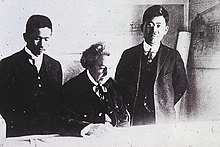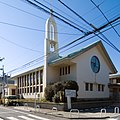Arata Endo
- View a machine-translated version of the Japanese article.
- Machine translation, like DeepL or Google Translate, is a useful starting point for translations, but translators must revise errors as necessary and confirm that the translation is accurate, rather than simply copy-pasting machine-translated text into the English Wikipedia.
- Do not translate text that appears unreliable or low-quality. If possible, verify the text with references provided in the foreign-language article.
- You must provide copyright attribution in the edit summary accompanying your translation by providing an interlanguage link to the source of your translation. A model attribution edit summary is
Content in this edit is translated from the existing Japanese Wikipedia article at [[:ja:遠藤新]]; see its history for attribution. - You may also add the template
{{Translated|ja|遠藤新}}to the talk page. - For more guidance, see Wikipedia:Translation.
Arata Endo | |
|---|---|
遠藤新 | |
 | |
| Born | (1889-06-01)June 1, 1889 Fukuda Village, Uta, Fukushima, Empire of Japan |
| Died | June 29, 1951(1951-06-29) (aged 62) Hongō, Bunkyō, Tokyo, Japan |
| Alma mater | Tokyo Imperial University |
| Occupation | Architect |
| Notable work | Jiyu Gakuen Girls' School Auditorium Kōshien Hotel |

Arata Endo (Japanese: 遠藤 新) (January 1, 1889 - June 29, 1951) was a Japanese architect. He was a disciple of Frank Lloyd Wright. One of his most important works was the Kōshien Hotel, the architectural style being heavily influenced by Wright's Imperial Hotel, Tokyo.
Biography
Arata Endo was educated at Tokyo Imperial University, now Tokyo University. In 1917–18, he was a disciple of Frank Lloyd Wright in his studio in Taliesin, a few miles south of Spring Green, Wisconsin, USA, and worked on Wright's project in Japan. He was an assistant to Wright in Japan with the Imperial Hotel in Tokyo in the early 1920s. Together they designed the Jiyu Gakuen Girls' School in Toshima, Tokyo, as well as the Tazaemon Yamamura House.
His largest and most famous work was the Kōshien Hotel in Nishinomiya in Hyōgo prefecture from 1930, whose style was influenced by the Imperial Hotel in Tokyo. He also designed several buildings for Jiyu Gakuen's Minamisawa campus. He accompanied the Japanese occupying forces to Manchukuo in the 1930s and was trapped after the war for a period in China before repatriation to Japan.
Arata Endo designed several schools with his sons Raku and Tou Endo. He died in 1951 while working with Mejirogaoka Church in the Mejiro district of Shinjuku, Tokyo. He was religious and a Christian.
Gallery
-
 Koshien Hotel
Koshien Hotel -
 Auditorium of Mooka City
Auditorium of Mooka City -
 Mejiro-ga-oka Church
Mejiro-ga-oka Church - Jiyu Gakuens girls school
-
 The auditorium in Jiyu Gakuen's girls' school
The auditorium in Jiyu Gakuen's girls' school
See also
External links
 Media related to Arata Endo at Wikimedia Commons
Media related to Arata Endo at Wikimedia Commons
- Wright in Japan | Arata Endo
- v
- t
- e
 | This article related to art or architecture in Japan is a stub. You can help Wikipedia by expanding it. |
- v
- t
- e
















